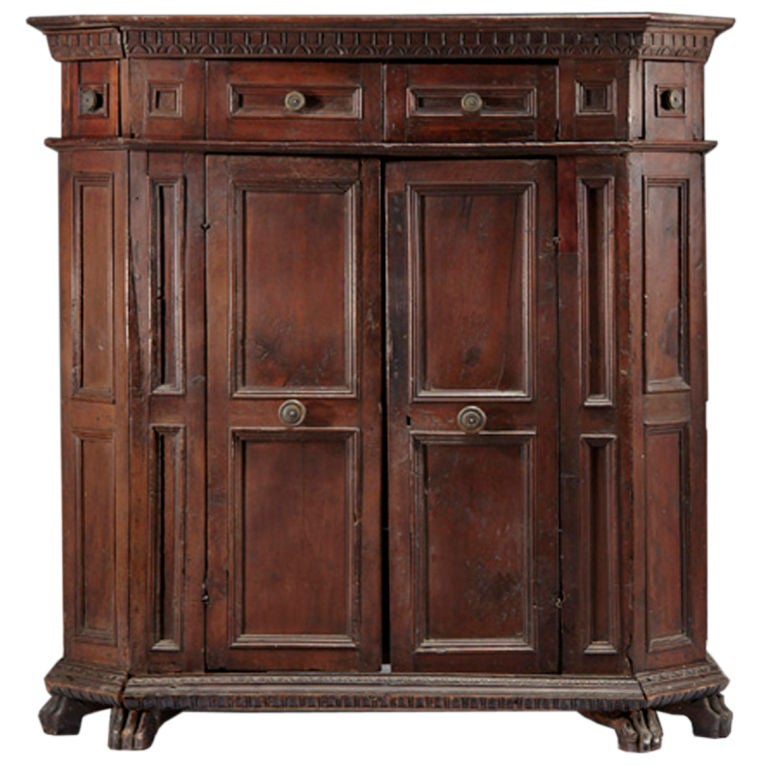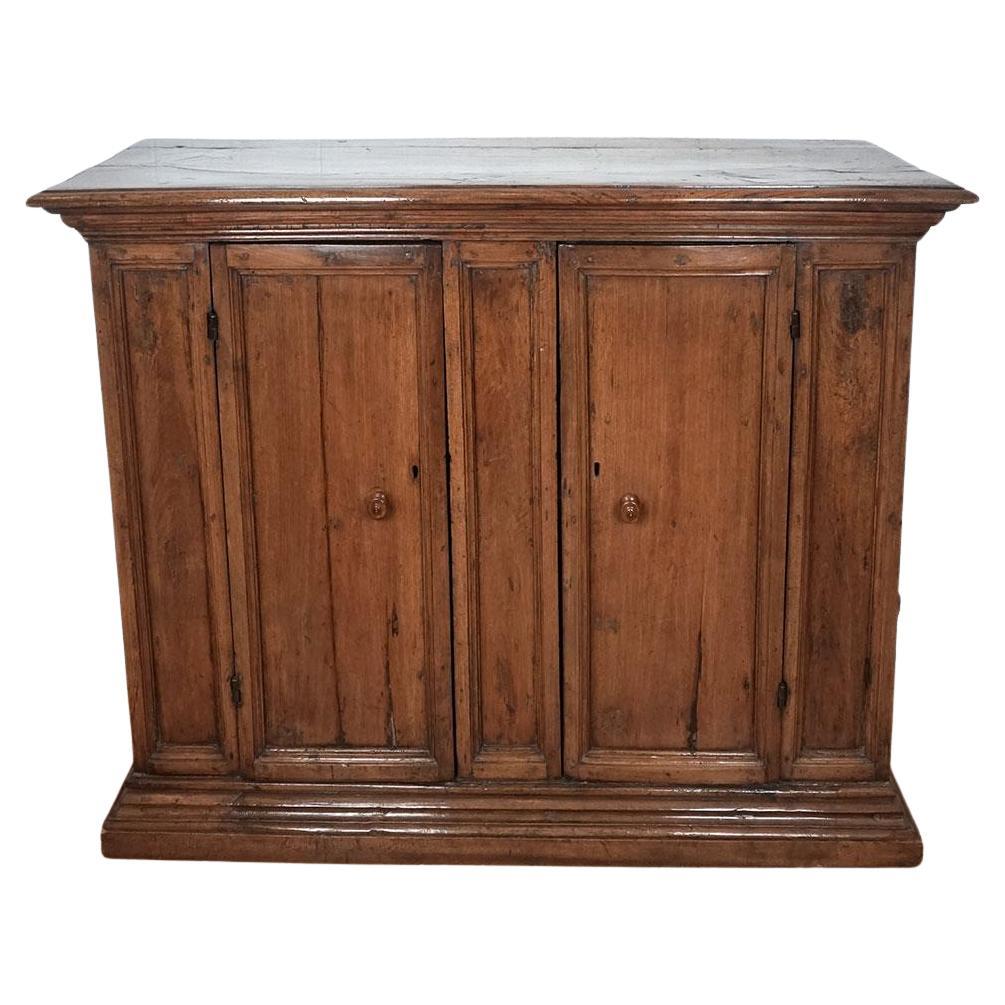Items Similar to Table Cabinet, Early 17th Century, Italian Baroque, Pietra Paesina Mounted Walnu
Want more images or videos?
Request additional images or videos from the seller
1 of 19
Table Cabinet, Early 17th Century, Italian Baroque, Pietra Paesina Mounted Walnu
About the Item
This cabinet is one of a small group that were made in the 1620s as taste and fashion veered towards the use of a paesina stone with its characteristic evocative veining which exhibits a strong ornamental pictorial structure. The 'marble' is a type of limestone, found in the Tuscan Apennine or on the island of Elba. When cut into slabs and polished it reveals a natural grain resembling mountainous landscapes, castles, and ruins. Pietra paesina, is also called “landscape stone,” “ruin stone,” “ruiniform marble,” and “Florentine marble” and has been collected for centuries.
Pietra Paesina is a silty limestone, found in Tuscany, formed during the Cretaceous period. It is a sedimentary stone mainly made of compressed limestone and clay formed in sea beds about 50 million years ago, with infiltrations of iron and manganese hydroxide which are responsible for the colorings. Although this stone has been used for ornamental purposes since ancient times, it is only from the 17th century onwards that its particular designs and its chromatic variations were appreciated and used sparingly to decorate the finest pieces of furniture.
The use of Paesina stone spread throughout Europe where it was highly regarded for its rarity as a precious ornament and was very much sought after and in demand in the Royal Courts. The Florentine artisans were highly regarded for their knowledge in identifying the intricate colors and patterning in the stone and then cutting and polishing it to reveal architectural motifs, mountainous landscapes, castles, and ruins. Pietra peasina inlay can be seen the Opificio delle Pietra Dure, Galleria Palatin in Palazzo Pitti.
The rectangular top and sides are of the cabinet are delicately, inlaid with rosewood and bone in geometric patterns with some old repairs to losses around the edges. Typically the central cupboard is executed as a tabernacle with a temple front. It has an ebony, architectural pediment with ripple mouldings and baluster turnings, and a pietra paesina oval above, revealing a drawer. The door below is disguised by a large, pietra paesina panel with black marble inlay creating an arch, faced with ripple mouldings and flanked by bold, ebony, ring, turned columns. It retains its original hinges and a period, working lock opening to reveal an interior compartment fitted with four drawers. The plinths below have three, pietra paesina panels faced with ebony, ripple mouldings revealing another drawer.
The front has six, long drawers either side of the tabernacle, each simulating a pair of smaller drawers, with pietra paesina panels within a geometric border of black & red marbles and faced with ripple and plain mouldings with bone inlay to create depth and perspective. They are all fitted with ebony knobs, have working locks, mostly original, some with replaced period locks and are lined in pine. One key operates all the locks. The carcass is pine. The cabinet stands on later, bun feet.
Provenance: Private Collecction
Literature: Monique Riccardo-Cubitt, The Art of the Cabinet, p. 191, fig. 37, p. 192, fig. 51.
Cabinet length 109 cm., 3ft., 6 ½ in., height 52.50 cm., 1ft., 8 ½ in., depth 33 cm., 12 ½ in.
A perspex table Stand has been commissioned to accommodate this cabinet, dimensions below
Length 114 cm., Depth 35 cm., Height 85 cm..
For a more traditional look the cabinet can be united with an 18th century, Spanish, walnut, cabinet table which is being sold separately
Table cabinet length 112 cm., 44 in., height 75 ½ cm., 29 ¾ in., depth 60 cm., 23 ¾ in.
Opificio Delle Pietra Dure
One of the famous artistic workshops of the Italian Renaissance, the Opificio was established in 1588 at the behest of Ferdinando I de' Medici to provide the elaborate, inlaid precious and semi-precious stoneworks. One of the masterpieces of the crafts is the overall decoration of the Cappella dei Principi (Chapel of Princes) in the Basilica di San Lorenzo di Firenze.
The technique, which originated from Byzantine inlaid work, was perfected by the Opificio masters and the artworks they produced became known as 'opere di Commessi Mediceo' (commesso is the old name of the technique, similar to ancient mosaics) and later as 'Commesso in Pietra Dure' (semi-precious stones mosaic). The artisans performed the exceptionally skilled and delicate task of inlaying thin veneers of semi-precious stones especially selected for their colour, opacity, brilliance and grain to create elaborate decorative and pictorial effects. Items of extraordinary refinement were created in this way, from furnishings to all manner of artworks.
Provenance: Private Collecction
Literature: Monique Riccardo-Cubitt, The Art of the Cabinet, p. 191, fig. 37, p. 192, fig. 51.
Reference:
• La Pittura su Pietra, Florence 1970 (M Chiarini)
• Museo dell’Opificio delle Pietre Dure of Florence (A. Pampaloni Martelli)
• La scritture delle pietre, (Roger Caillois)
• L’ecriture des pierres, les sentiers de al creation (Rogere Callois)
• Pietre figurate. Collezioni invisbili, Regional Museum of Natural Science Turin (P Mariano Gallo)
• La Pietre Paesina in; bizzarrie di pietre dipinte dalla collezioni dei Medici Salimbeni Foundation, San Severina Marche, Silvana Editoriale 2000 (Nichola Cipriani).
- Dimensions:Height: 21.26 in (54 cm)Width: 42.92 in (109 cm)Depth: 13 in (33 cm)
- Style:Baroque (Of the Period)
- Materials and Techniques:
- Place of Origin:
- Period:Early 17th Century
- Date of Manufacture:1600-1650
- Condition:Replacements made: see cataloguing.
- Seller Location:BUNGAY, GB
- Reference Number:1stDibs: LU3867315797942
About the Seller
5.0
Vetted Seller
These experienced sellers undergo a comprehensive evaluation by our team of in-house experts.
Established in 1985
1stDibs seller since 2018
84 sales on 1stDibs
Typical response time: 7 hours
- ShippingRetrieving quote...Ships From: BUNGAY, United Kingdom
- Return PolicyA return for this item may be initiated within 7 days of delivery.
More From This SellerView All
- Table Cabinet, Mid-17th Century, Flemish Baroque, Ebonized and TortoishellLocated in BUNGAY, SUFFOLKThis cabinet was made in Flanders in the mid-17th century as a prestigious item for an affluent member of the professional classes. The significant amount of tortoishell employed dem...Category
Antique Mid-17th Century European Baroque Cabinets
MaterialsTortoise Shell
- Cassone, 17th Century, Italian, Baroque, Vernacular, Walnut, Carved, HeartsLocated in BUNGAY, SUFFOLKThis handsome cassone has ornament with romantic associations and was most likely a marriage chest. It is a good example of the Italian vernacular, simple in a sophisticated manner. ...Category
Antique Late 17th Century Italian Baroque Blanket Chests
MaterialsWalnut
- Chest, Cassone, 17th Century, Portuguese, Baroque, Brazil, HardwoodLocated in BUNGAY, SUFFOLKThis striking chest is made from a Brazilian hardwood which I have not been able to identify. The color and figuring of the timber together with the Classic form and ornamentation su...Category
Antique Late 17th Century Portuguese Baroque Blanket Chests
MaterialsHardwood
- Lamp Table Candlestick Pewter 17th Century BaroqueLocated in BUNGAY, SUFFOLKExceptionally rare, 17th century, pewter candlestick upcycled into a table lamp, 20” high Elegant, classical form typical of the Baroque period, with all the surfaces reflecting l...Category
Antique 1690s French Baroque Table Lamps
MaterialsPewter
- Armchair, chair, 17th Century, Italian, Walnut, Scroll, Baroque, TapestryLocated in BUNGAY, SUFFOLKThis elegant armchair exudes classic gravitas, with scroll arms, fall turnings and triple toe feet The tapestry back depicting Flora underneath a bower is a distinctive feature. It...Category
Antique 17th Century Italian Baroque Armchairs
MaterialsWalnut
- Lamps Table Pair Candlesticks Silver Gilt 17th Century Baroque Italian 29" highLocated in BUNGAY, SUFFOLKFine pair of late 17th century, Italian, carved & gilded pricket candlesticks upcycled into table lamps, 29” high Finely carved with classical turnings and ornamentation of the Baro...Category
Antique 1690s Italian Baroque Table Lamps
MaterialsBeech
You May Also Like
- Italian early 17th century Baroque armadio / CabinetLocated in Troy, NYStriking Tuscan cabinet with canted corners. Four drawers above two doors, on later paw-feet (can be taken off). Beautiful rich color. Our pieces are left in lived-in condition, pe...Category
Antique 17th Century Italian Baroque Wardrobes and Armoires
MaterialsWalnut
- Italian 17th century Baroque walnut Credenza or Small CabinetLocated in Troy, NYDecorative mid-size credenza / cabinet with nice patina. The front withcarved decoration, two small drawers over paneled doors.Category
Antique 17th Century Italian Baroque Credenzas
MaterialsWalnut
- Italian Baroque 17th century small walnut Cabinet or BookcaseLocated in Troy, NYTuscan cabinet or bookcase of unusual diminutive proportions and wonderful light honey color. The four doors opening to shelved interiors, on bracket feet.Category
Antique 17th Century Italian Baroque Wardrobes and Armoires
MaterialsWalnut
- Remarkable Late 17th Century Swedish Baroque CabinetLocated in Mjöhult, SERemarkable and rare late 17th century ebonized Baroque cabinet in it's original finish with wonderful patination. Ca 1690 Sweden, possibly Norwa...Category
Antique 17th Century Swedish Baroque Cabinets
MaterialsWood
- 17th Century Italian Walnut CabinetLocated in Montreal, QC17th century Italian walnut buffet-cabinet, probably Tuscan c.1680Category
Antique 1680s Italian Baroque Cabinets
MaterialsWalnut
- Italian Counter Cabinet 17th CenturyBy Europa AntiquesLocated in Madrid, ESCOUNTER cabinet 17th century. Italian, in different woods, inlaid and engraved bone plaques, felling top, ten drawers inside and a hatch with two draw...Category
Antique 16th Century Italian Baroque Cabinets
MaterialsBronze
Recently Viewed
View AllMore Ways To Browse
Table Top Cabinet
Antique Table Cabinet
Antique Cabinet Table
Early Baroque
Early Baroque Furniture
Antique Looking Cabinets
Antique Cabinet Look
Antique Looking Storage Cabinet
Antique Table Top Cabinet
Marble Mounted Cabinet
Small Cabinet Table
Small Italian Cabinet
Long Side Cabinet
Cabinet Pair Italy
Pair Italian Cabinets
Large Italian Cabinet
Cabinet 17th
Old Master Pieces





